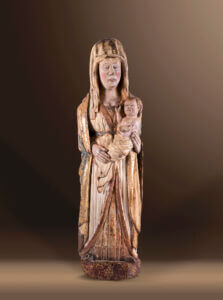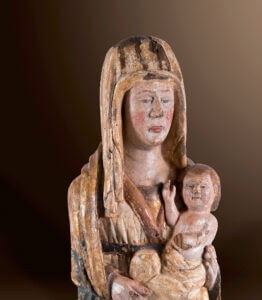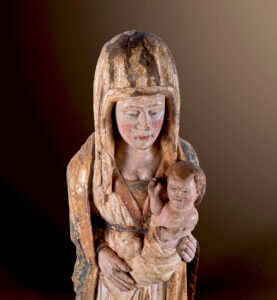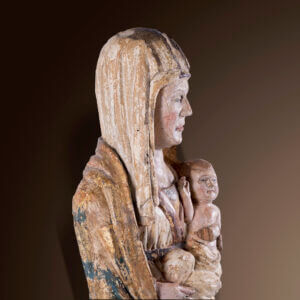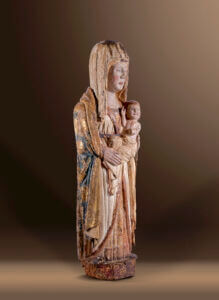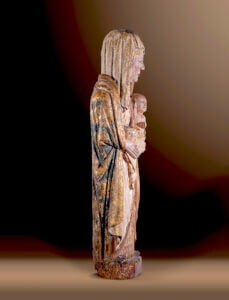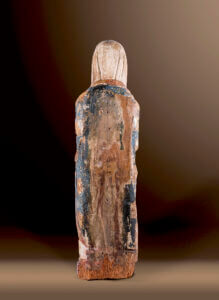This Madonna figure was created around 1300 in the Lake Constance region. It is carved from wood, has a height of 59 cm and wears its original polychrome frame. The object comes from a renowned Swiss private collection. The Madonna stands on a small wooden pedestal with rosette patterns and is conceived in a static, imperious manner due to the blocky, vertical elaboration. Maria has an elongated, oval face with red cheeks. A veil is thrown over her hair, which appears like a cap due to the strong elevation, with the coiled ends framing her face and falling over her shoulders. She wears a cape that reaches down to her legs; the multi-layered dress is detailed and belted, especially at the bodice, with the undergarment emerging from beneath the divided sections of fabric. She holds the infant Jesus pressed against her, which is wrapped here in a piece of cloth in a rare design reminiscent of Byzantine representations.
It reaches for the mother’s veil or robe with its right hand and seems to be playing with it. This gesture exists as a new element in late 13th century icon painting, for example in Duccio di Buoninsegna. This active gesture brings the representation to life and emphasizes the human aspect of Christ. It also emphasizes the intimate relationship between mother and child. However, the child is not looking at Mary, but into the distance; Mary herself has her gaze directed forward, probably toward the believer for whom she acts as intercessor. Here, in the transition to Gothic, her expression still seems somewhat aloof. The infant Jesus typically wears adult-looking facial features that refer to the wisdom of Christ and the Sedes Sapientiae (“Throne of Wisdom”). Thus, the figure acquires didactic and spiritual character.
The early Gothic work is comparable to two of the same enthroned Madonna representations of the late Romanesque period: the so-called Ulm Madonna from the second half of the 13th century from Upper Swabia (Ulm Museum, Inv.-No. 1932.7494) and the so-called Kirchhaslach Madonna of the 13th century from Swabia/Unterallgäu. They resemble each other mainly in the elongated head shape and static composition. These examples show Mary in the Romanesque type of the “Throne of Wisdom,” referencing the Byzantine depictions of Mary as the Mother of God. These full-round wooden sculptures were mobile figures that were often carried in procession on certain feast days. The sculpture was the sign of Mary’s presence and authority, in enthroned representation with a strict frontality as well as with symmetrical folds of the simple garment.
Although in this figure certain characteristics coincide with the Romanesque figures, this type is already changing to a standing Madonna with a human component. Furthermore, the cap-like helmet of this figure of Mary is related to that of the presbyter Martinus of 1199, from the Camaldolese monastery in Borgo San Sepolcro near Arezzo. Typically, in most Romanesque depictions of Mary, the veil is shown resting tightly on the calotte; therefore, this is likely a retarding, regional type in which there appears to be a high cap under the veil that further elongates Mary’s narrow face. The stylized large head still refers to the Romanesque tradition of enthroned Madonnas, while the overall elongation and playful gestures of the child already herald the beginning of the Gothic period. This is a museum sculpture from the early period of Gothic sculpture in the Lake Constance area.
https://artsandculture.google.com/asset/madonna-als-sedes-sapentiae/NgGGBATW5AAqFQ?hl=de
